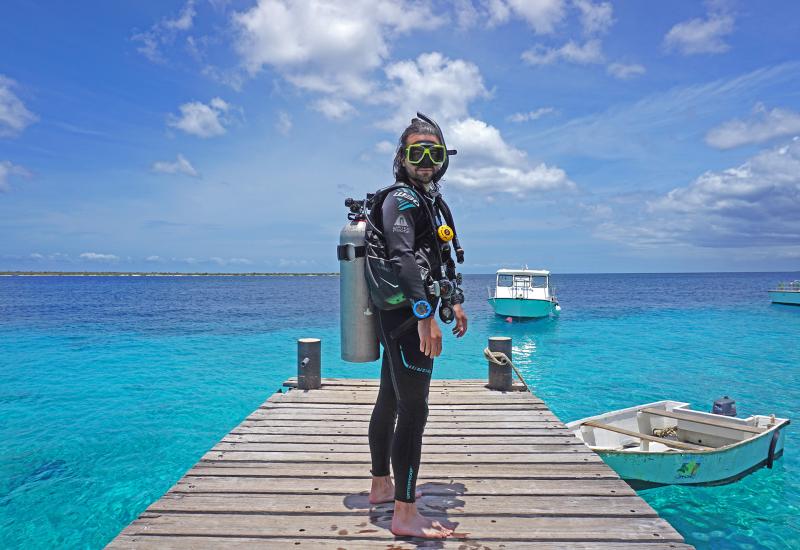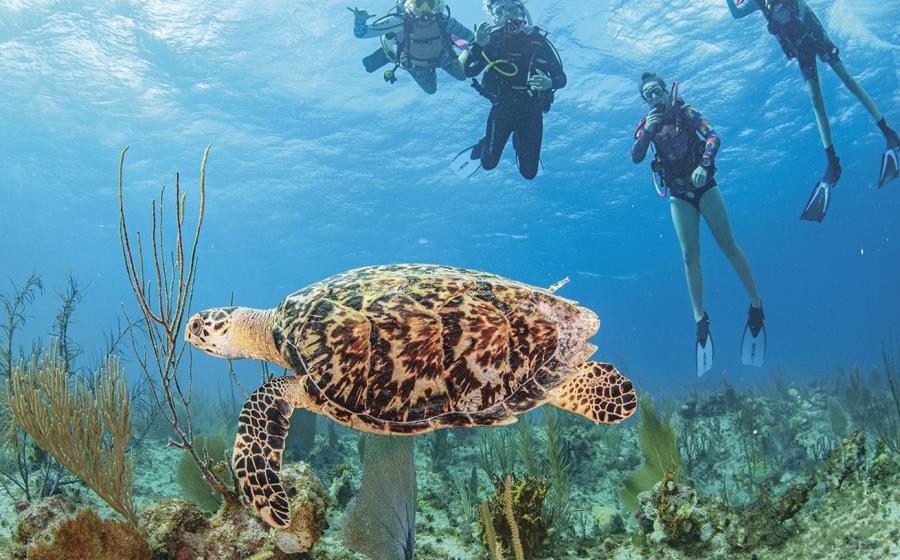The Life of a Commercial Scuba Diver
Offshore divers are a small fraternity. In the busiest times, there are only about 1,600 divers employed offshore in the Gulf of Mexico, the most active area for commercial diving. During the last 25 years, most of us have either come from a military background or graduated from a commercial dive school. To become a commercial diver, you'd better love vessels and big seas and being out of the sight of land and home for weeks, if not months, at a time. When I worked in the Tasman Sea in the late '70s, it was not uncommon to have the odd 20- to 30-foot swell come out of nowhere. On one occasion, 75-foot seas washed over our platform. We worked a minimum of 12 hours a day, but that could easily go to 14 to 16 for weeks on end. When there was an emergency, we dove when we were told to dive. It seemed like 3 a.m. was the perfect time for something on the rig to break. If there is an elite group of divers, perhaps the title sat diver is as good as it gets. There is a down side to sat diving, though. While credit is being passed around, you are stuck in a deck chamber the size of a very small Airstream trailer, often for long periods of time - sometimes 10 days, sometimes 40. It all depends on how well the project was engineered and how the weather held. As a rule of thumb, one day of decompression is spent for each 100 feet of depth. Thus, on a 1,000-foot sat, the diver spends literally 10 days waiting for that large chamber door to reach one atmosphere of pressure. Sitting in the chamber for 20 days is similar to being in a culture medium. The humidity is high, and the constant fluctuation in temperature makes antibiotics a diver's best friend. I have traveled to all the continents (except Antarctica), not once, but several times: I've worked Angola, Cameroon, Equatorial Guinea, Burma, Vietnam, China, Norway, anywhere the gods of oil and gas have reared their hallowed heads. The routine is grueling. Drive to the airport, fly to Japan, connect to Indonesia, clear customs, catch the transport to the helideck, fly offshore, put on your coveralls, dive, dive, dive. The only thing you were intensely aware of was staying alert as a myriad of tools started descending the down line. I've been lucky. We try not to use that word too often offshore, but if you watch closely you'll notice that many of us have some idiosyncrasy in our routines. My own quirk is to wear blue shorts under my wetsuit. In 20-plus years, I've never dived without those blue shorts. Sounds weird, but if that's what it takes ... A buddy, Jay, chews cinnamon gum before the hatch of his one-atmosphere dive suit closes. Divers talk about their dive hats like they were their children. And we don't talk too much about accidents. Yes, I have been lucky. In the last decade, diving has become much safer; nonetheless, there is always the risk. I haven't seen a fatality yet. The worst experience I had was finding Geoff on the bathroom floor convulsing from a CNS hit. After a 36-hour treatment, he walked out with no residual problems. However, I have many supervisor friends who have watched their best friends not make it back to the surface alive. Diving bell portholes blew in, faceplates blew out from O2 explosions while burning underwater, or they were sent the wrong breathing gas. There are human errors, equipment malfunctions and bad weather, and often a combination of the three. Then there are the few PNS hits that never resolve. It's not the first topic of conversation, but when you get to know a diver who's had a bad accident, it always comes out, and it's always somber. When the weather is nice and the vis is good, I often think, We get paid for this? Unfortunately, that happens only half the time; the rest is spent living and working in controlled chaos. While there is a sense of teamwork, we most always work alone, a singular entity responsible for coordinating a lot of tasks in which a single wrong decision could have dire consequences. It could be as simple as stabbing a conductor in a bell guide, usually the right bell guide. (The conductor is the pipe that brings oil and gas to the surface and must be placed through a series of guides on the platform for correct alignment). The wrong one costs several million dollars. My finest hour in commercial diving was not a singular event, instead it's been the continuing journey, now just passing two decades. Commercial diving is a physical and mental labyrinth weaving through cold, murky water; fouled umbilicals; lost communication; Force 9 seas; mobilizations and demobilizations, boat to boat and country to country. On some days, especially when the water is warm and crystal blue, with the energy from the welding arc or the water blaster's cavitating flame, there seems to be a liquid magic. Diving is the vehicle to the job, jobs so diverse and often many nautical miles from a stocked tool room. Divers burn, cut, jet, weld, inspect, construct and scrap. Defining moments are often in the rigging, but more so in the jury rigging. The diver by necessity is the master of invention. Seldom is a diving job only about the diving team. It is the relationship with the vessel master, the customer's engineers and reps, regulatory bodies and surveyors. Since only the diver can physically get to the job site, the mystique lies with the diver, and thus he is either the weakest or strongest link. Those who understand realize that trust is supreme, and the links only strengthen. Someday, my hat will be put away. Many of us never sell our hats; a few put them on the mantle; others just store them in the closet. Many friends and experiences have accumulated along the way: hanging off at the 20-foot stop, protected in a hot-water suit, a cloud of bioluminescent comb jellies wafting slowly by in the current. And then the hot-water stops. That's commercial diving: all the good times and all the tough times. I wouldn't have it any other way. For more information about becoming a commercial diver in the oil fields, click onto the home page below.










